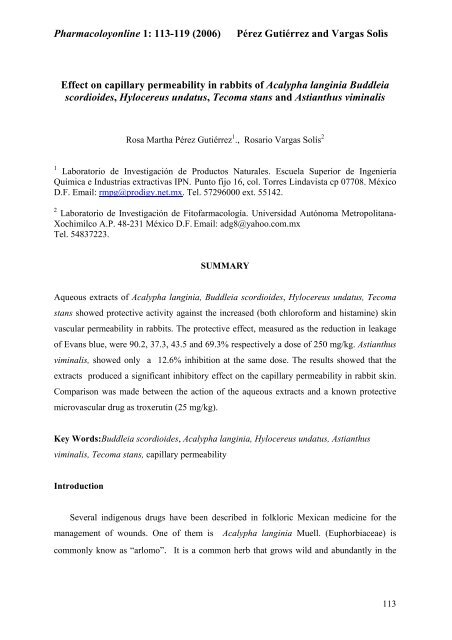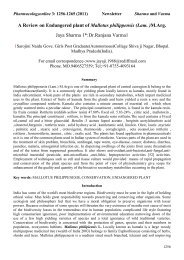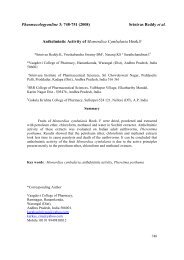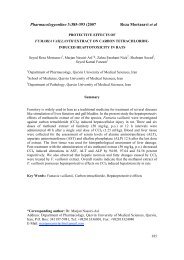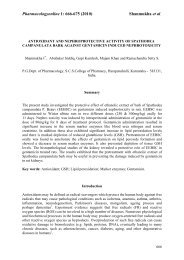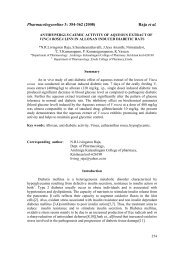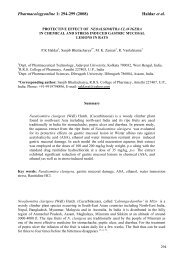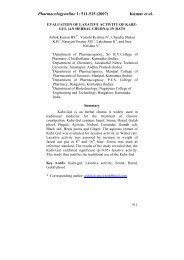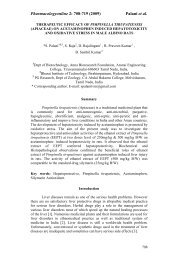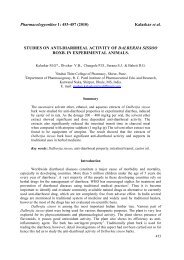Effect on capillary permeability in rabbits of Acalypha
Effect on capillary permeability in rabbits of Acalypha
Effect on capillary permeability in rabbits of Acalypha
You also want an ePaper? Increase the reach of your titles
YUMPU automatically turns print PDFs into web optimized ePapers that Google loves.
Pharmacoloy<strong>on</strong>l<strong>in</strong>e 1: 113-119 (2006) Pérez Gutiérrez and Vargas Solìs<br />
<str<strong>on</strong>g>Effect</str<strong>on</strong>g> <strong>on</strong> <strong>capillary</strong> <strong>permeability</strong> <strong>in</strong> <strong>rabbits</strong> <strong>of</strong> <strong>Acalypha</strong> lang<strong>in</strong>ia Buddleia<br />
scordioides, Hylocereus undatus, Tecoma stans and Astianthus vim<strong>in</strong>alis<br />
Rosa Martha Pérez Gutiérrez 1 ., Rosario Vargas Solís 2<br />
1 Laboratorio de Investigación de Productos Naturales. Escuela Superior de Ingeniería<br />
Química e Industrias extractivas IPN. Punto fijo 16, col. Torres L<strong>in</strong>davista cp 07708. México<br />
D.F. Email: rmpg@prodigy.net.mx. Tel. 57296000 ext. 55142.<br />
2 Laboratorio de Investigación de Fit<strong>of</strong>armacología. Universidad Autónoma Metropolitana-<br />
Xochimilco A.P. 48-231 México D.F. Email: adg8@yahoo.com.mx<br />
Tel. 54837223.<br />
SUMMARY<br />
Aqueous extracts <strong>of</strong> <strong>Acalypha</strong> lang<strong>in</strong>ia, Buddleia scordioides, Hylocereus undatus, Tecoma<br />
stans showed protective activity aga<strong>in</strong>st the <strong>in</strong>creased (both chlor<strong>of</strong>orm and histam<strong>in</strong>e) sk<strong>in</strong><br />
vascular <strong>permeability</strong> <strong>in</strong> <strong>rabbits</strong>. The protective effect, measured as the reducti<strong>on</strong> <strong>in</strong> leakage<br />
<strong>of</strong> Evans blue, were 90.2, 37.3, 43.5 and 69.3% respectively a dose <strong>of</strong> 250 mg/kg. Astianthus<br />
vim<strong>in</strong>alis, showed <strong>on</strong>ly a 12.6% <strong>in</strong>hibiti<strong>on</strong> at the same dose. The results showed that the<br />
extracts produced a significant <strong>in</strong>hibitory effect <strong>on</strong> the <strong>capillary</strong> <strong>permeability</strong> <strong>in</strong> rabbit sk<strong>in</strong>.<br />
Comparis<strong>on</strong> was made between the acti<strong>on</strong> <strong>of</strong> the aqueous extracts and a known protective<br />
microvascular drug as troxerut<strong>in</strong> (25 mg/kg).<br />
Key Words:Buddleia scordioides, <strong>Acalypha</strong> lang<strong>in</strong>ia, Hylocereus undatus, Astianthus<br />
vim<strong>in</strong>alis, Tecoma stans, <strong>capillary</strong> <strong>permeability</strong><br />
Introducti<strong>on</strong><br />
Several <strong>in</strong>digenous drugs have been described <strong>in</strong> folkloric Mexican medic<strong>in</strong>e for the<br />
management <strong>of</strong> wounds. One <strong>of</strong> them is <strong>Acalypha</strong> lang<strong>in</strong>ia Muell. (Euphorbiaceae) is<br />
comm<strong>on</strong>ly know as “arlomo”. It is a comm<strong>on</strong> herb that grows wild and abundantly <strong>in</strong> the<br />
113
Pharmacoloy<strong>on</strong>l<strong>in</strong>e 1: 113-119 (2006) Pérez Gutiérrez and Vargas Solìs<br />
fields <strong>of</strong> Mexico. A water extract <strong>of</strong> the leaves has l<strong>on</strong>g been used for <strong>in</strong>digenous when<br />
abundant hemorrhages are present dur<strong>in</strong>g postpartum, it is applied as a vag<strong>in</strong>al wash (1).<br />
Previous <strong>in</strong>vestigati<strong>on</strong>s a survey <strong>of</strong> literature showed has been d<strong>on</strong>e for the above menti<strong>on</strong>ed<br />
activity.<br />
B. scordioides bel<strong>on</strong>g<strong>in</strong>g to the family Loganiaceae. It is comm<strong>on</strong>ly know as “lengua de<br />
vaca” is used <strong>in</strong> traditi<strong>on</strong>al medic<strong>in</strong>e for various types <strong>of</strong> illnesses. It is a comm<strong>on</strong> herb that<br />
grows wild and abundantly <strong>in</strong> the fields <strong>of</strong> Mexico. A water extract <strong>of</strong> the leaves has l<strong>on</strong>g<br />
been used for Guerrero <strong>in</strong>digenous for the treatment <strong>of</strong> wounds and the use <strong>in</strong> Aguascalientes<br />
<strong>of</strong> powdered leaves to treat ulcers was reported a l<strong>on</strong>g time ago (1). Decocti<strong>on</strong> <strong>of</strong> the roots is<br />
drunk for the treatment <strong>of</strong> hepatitis. Decocti<strong>on</strong> <strong>of</strong> the root or the leaves is also used to wash<br />
wounds and a powder <strong>of</strong> the same plant parts is applied topically as a wound healer.<br />
Buddleia scordioides <strong>in</strong> the literature survey <strong>in</strong>dicated that the flav<strong>on</strong>oids rut<strong>in</strong>, quercet<strong>in</strong><br />
and quercetr<strong>in</strong>a were isolated from Buddleia scordioides (2). Other compounds isolated<br />
<strong>in</strong>clude syr<strong>in</strong>g<strong>in</strong>, saikogen<strong>in</strong> A, 3,23,28-trihydroxyoleana-11,13(18)-diene, peracetate <strong>of</strong> 3-<br />
O-α-L-ramnopyranosyl-(1→4)-β-D-glucopyranosyl-[(1→3)-β-D-glucopyranosyl-(1→2)]-β-D-<br />
fucopyranosyl-3,23,28-trihydroxyoleane-l1,13(18)-diene, 3-O-α-L-rhamno pyranosyl-(1→4)-<br />
β-D-glucopyranosyl-(1→3)-[β-D-glucopyranosyl-(1→2)]-β-D-fucopyranosyl-3,16,23,28-tetra<br />
hydroxyoleane-11,13(18)-diene, and peracetate <strong>of</strong> buddlejasap<strong>on</strong><strong>in</strong> I (3).<br />
Hylocereus undatus (Haworth), is a Cactaceae widely distributed from the coast <strong>of</strong><br />
Florida to Brazil. Its fruit is named “pitahaya orej<strong>on</strong>a” because <strong>of</strong> the shape <strong>of</strong> the scales <strong>on</strong><br />
the fruit sk<strong>in</strong>; it is also known as “ Queen <strong>of</strong> the night” because <strong>of</strong> its exquisitely fragrant<br />
large flowers that <strong>on</strong>ly open for the night (4). For their peculiar appearance have received<br />
special attenti<strong>on</strong> <strong>in</strong> Mexico for a l<strong>on</strong>g time, history and folklore have recorded this<br />
importance am<strong>on</strong>g prehispanic tribes (5), Played an important role, as food, medic<strong>in</strong>e (6), and<br />
ornamentally (7). Currently, the pitahaya is a highly ec<strong>on</strong>omical crop for the traditi<strong>on</strong>al<br />
producer because little or no <strong>in</strong>vestment is required for its cultivati<strong>on</strong>. Therefore, it can be<br />
c<strong>on</strong>sidered an alternative crop with high commercial potential (8). Its leaves and flowers are<br />
traditi<strong>on</strong>ally used by Mayas as hypoglycaemic, diuretic and cicatrizant agent (1).<br />
Astianthus vim<strong>in</strong>alis (H.B.K.) Baill<strong>on</strong> bel<strong>on</strong>g<strong>in</strong>g to the family Bign<strong>on</strong>iaceae. It is comm<strong>on</strong>ly<br />
know as “Azúchil” is used <strong>in</strong> traditi<strong>on</strong>al medic<strong>in</strong>e for treatment <strong>of</strong> diabetes. This plant<br />
showed the presence <strong>of</strong> iridoid glucosides campenoside, 5-hydroxycampenoside, stansioside<br />
and plantarenaloside, also c<strong>on</strong>ta<strong>in</strong>ed the acids ursolic, oleanolic, p-methoxyc<strong>in</strong>amic, (9). The<br />
methanol extract <strong>of</strong> A. vim<strong>in</strong>alis exhibited significantly hypoglycemic activity.<br />
114
Pharmacoloy<strong>on</strong>l<strong>in</strong>e 1: 113-119 (2006) Pérez Gutiérrez and Vargas Solìs<br />
Tecoma stans Juss (Bign<strong>on</strong>iaceae) is widely distributed <strong>in</strong> Central America and is<br />
cultivated <strong>in</strong> West Africa. The leaves have enjoyed a wide use by the natives <strong>of</strong> Mexico <strong>in</strong><br />
the c<strong>on</strong>trol <strong>of</strong> diabetes. Phytochemical studies have resulted <strong>in</strong> the characterizati<strong>on</strong> <strong>of</strong><br />
stansioside, stanside, plantarrenanoside, 5-deoxystansioside, plantarenaloside, 5deoxylamioside,<br />
yuhe<strong>in</strong>oside (10), tecostan<strong>in</strong>e, tecostid<strong>in</strong>e, δ-skytanth<strong>in</strong>e, 3,9,12,15-<br />
octadecatetraenoic acid, N-normethyl skytanth<strong>in</strong>e, noract<strong>in</strong>id<strong>in</strong>e, 7-hydroxyskytanth<strong>in</strong>e, ∆ 4a -<br />
dihydroxyskytanth<strong>in</strong>e and boschniak<strong>in</strong>e (11).<br />
Methods<br />
Plant material. The leaves, <strong>of</strong> Hylocereus undatus were collected <strong>in</strong> the state <strong>of</strong> Oaxaca,<br />
Mexico, and were tax<strong>on</strong>omically authenticated <strong>in</strong> the Department <strong>of</strong> Natural Resources <strong>of</strong><br />
CIDIR-IPN and a voucher specimen (No. A-843) has been deposited at herbarium <strong>of</strong> this<br />
Department for reference. The leaves <strong>of</strong> Buddleia scordioides were collected <strong>in</strong> the state <strong>of</strong><br />
Guerrero, Mexico. The material was identified <strong>in</strong> the Department <strong>of</strong> Botany <strong>of</strong> ENEP-<br />
Iztacala UNAM and a voucher specimen (No. 7976) <strong>of</strong> the plant is stored <strong>in</strong> the herbarium <strong>of</strong><br />
this Department for reference. The leaves <strong>of</strong> <strong>Acalypha</strong> lang<strong>in</strong>ia were collected <strong>in</strong> the state <strong>of</strong><br />
Colima, Mexico, and were tax<strong>on</strong>omically authenticated <strong>in</strong> the Department <strong>of</strong> Botany <strong>of</strong><br />
ENEP-Iztacala UNAM and a voucher specimen (No. 7912) are kept at the herbarium <strong>of</strong> this<br />
Department for reference. The leaves <strong>of</strong> Astianthus vim<strong>in</strong>alis were collected <strong>in</strong> the state <strong>of</strong><br />
Morelos, Mexico, and was identified <strong>in</strong> the Department <strong>of</strong> Botany <strong>of</strong> UAM-Xochimilco and<br />
a voucher specimen (No. 4652) <strong>of</strong> the plant is stored <strong>in</strong> the herbarium <strong>of</strong> this Department for<br />
reference. Tecoma stans was collected <strong>in</strong> the state <strong>of</strong> Mexico, Mexico, and were<br />
tax<strong>on</strong>omically authenticated <strong>in</strong> the Department <strong>of</strong> Botany <strong>of</strong> UAM-Xochimilco and a<br />
voucher specimen is deposited <strong>in</strong> the herbarium <strong>of</strong> this Department for reference with<br />
registrati<strong>on</strong> number 4723.<br />
Animals. Young adult, <strong>rabbits</strong> weigh<strong>in</strong>g 2000-2800 g, both sexes were used. The animals<br />
were ma<strong>in</strong>ta<strong>in</strong>ed with pellet foot (Pur<strong>in</strong>a), while tap water was available ad libitum. The<br />
procedures <strong>in</strong>volv<strong>in</strong>g animals and their care c<strong>on</strong>formed to the <strong>in</strong>ternati<strong>on</strong>al guidel<strong>in</strong>es<br />
Pr<strong>in</strong>ciples <strong>of</strong> Laboratory Animals Care.<br />
115
Pharmacoloy<strong>on</strong>l<strong>in</strong>e 1: 113-119 (2006) Pérez Gutiérrez and Vargas Solìs<br />
Preparati<strong>on</strong> <strong>of</strong> the aqueous extract. Fresh leaves <strong>of</strong> B. scordioides, were dried at room<br />
temperature and ground <strong>in</strong>to a f<strong>in</strong>d powder. 300 g <strong>of</strong> powder was heated to reflux<br />
temperature (Soxhlet) with 2 L <strong>of</strong> water for 30 m<strong>in</strong>. The aqueous extract was filtered <strong>on</strong><br />
Whatman paper. The filtrates obta<strong>in</strong>ed were lyophilized gave a residue green (yield obta<strong>in</strong>ed<br />
was <strong>of</strong> 5.6%) and stored at room temperature until use. A small quantity <strong>of</strong> water (volumes<br />
to cover the entire wound surface) was added to the lyophilized B. scordioides powder, and<br />
different c<strong>on</strong>centrati<strong>on</strong>s <strong>of</strong> galenical product (25, 100, 150, 200 and 250 mg/ml) <strong>in</strong> sterile<br />
gum soluti<strong>on</strong> were prepared for studies.<br />
<str<strong>on</strong>g>Effect</str<strong>on</strong>g> <strong>on</strong> <strong>capillary</strong> <strong>permeability</strong> <strong>in</strong> <strong>rabbits</strong>. The male <strong>rabbits</strong> (2 kg mean weight, 12<br />
animals <strong>in</strong> each experimental group) were treated <strong>in</strong>traperit<strong>on</strong>eally with either NaCl (0.9% )<br />
(c<strong>on</strong>trol group) or the extract or troxerut<strong>in</strong> (25 mg/kg and as a 2.5% soluti<strong>on</strong> <strong>in</strong> water). After<br />
30 m<strong>in</strong>, three z<strong>on</strong>es <strong>of</strong> depilated sk<strong>in</strong> were irritiated with chlor<strong>of</strong>orm applied by means <strong>of</strong> a<br />
cott<strong>on</strong> tipped glass tube pressed lightly <strong>on</strong> the sk<strong>in</strong> for 30 s. After a further 60 m<strong>in</strong> the<br />
histam<strong>in</strong>e was adm<strong>in</strong>istered <strong>in</strong>tradermally, 0.8 µg to each <strong>of</strong> the three z<strong>on</strong>es (i.e. 2.4<br />
µg/rabbit), followed by immediate <strong>in</strong>travenous applicati<strong>on</strong> <strong>of</strong> Evans blue (25 mg/kg, as 10%<br />
aqueous soluti<strong>on</strong>). The animals were killed 30 m<strong>in</strong> after histam<strong>in</strong>e adm<strong>in</strong>istrati<strong>on</strong> and the<br />
sk<strong>in</strong> z<strong>on</strong>es (each 3 x 3 cm) were accurately cut <strong>of</strong>f and extracted with 4 mL formamide for 72<br />
h at 45°. The absorpti<strong>on</strong> <strong>of</strong> the decanted supernatant was measured at 620 nm and the Evans<br />
blue c<strong>on</strong>tent read from the calibrati<strong>on</strong> curve (12).<br />
Results<br />
All extracts with the excepti<strong>on</strong> <strong>of</strong> A. vim<strong>in</strong>alis significantly <strong>in</strong>hibited <strong>capillary</strong> <strong>permeability</strong><br />
<strong>in</strong> <strong>rabbits</strong> and showed a c<strong>on</strong>centrati<strong>on</strong>-dependent. The protective microvascular activity was<br />
measured as a counteract<strong>in</strong>g effect <strong>on</strong> the leakage <strong>of</strong> Evans blue <strong>in</strong>troduced <strong>in</strong>travenously.<br />
Troxerut<strong>in</strong> (25 mg/kg) a protective microvascular was used as reference drug <strong>in</strong> this study.<br />
The results <strong>of</strong> aqueous extract <strong>of</strong> A. lang<strong>in</strong>ia are shown <strong>in</strong> Table 1. The aqueous extract <strong>of</strong><br />
A. lang<strong>in</strong>ia 120 m<strong>in</strong> after perit<strong>on</strong>eal treatment at a dose <strong>of</strong> 150 and 200 mg/kg <strong>of</strong> extract<br />
produced a <strong>in</strong>hibitory effect <strong>on</strong> the <strong>capillary</strong> <strong>permeability</strong> <strong>in</strong> rabbit sk<strong>in</strong> <strong>in</strong>creased by<br />
chlor<strong>of</strong>orm and histam<strong>in</strong>e 30 and 90 m<strong>in</strong> <strong>of</strong> 73.2 and 81.4% respectively. This effect was<br />
116
Pharmacoloy<strong>on</strong>l<strong>in</strong>e 1: 113-119 (2006) Pérez Gutiérrez and Vargas Solìs<br />
more pr<strong>on</strong>ounced at 250 mg/kg (90.2% reducti<strong>on</strong>). The protective microvascular activity <strong>of</strong><br />
B. scordioides, is shown <strong>in</strong> the Table 2.<br />
Table 1. <str<strong>on</strong>g>Effect</str<strong>on</strong>g> <strong>of</strong> the aqueous extract <strong>of</strong> <strong>Acalypha</strong> lang<strong>in</strong>ia <strong>on</strong> <strong>in</strong>creased microvascular<br />
<strong>permeability</strong> <strong>in</strong>duced by both chlor<strong>of</strong>orm and histam<strong>in</strong>e <strong>in</strong> <strong>rabbits</strong>.<br />
Treatment mg/kg Inhibiti<strong>on</strong> (%)<br />
0.9% NaCl 0<br />
25 10.1<br />
100 61.5<br />
150 73.2<br />
200 81.4<br />
250 90.2<br />
Troxerut<strong>in</strong> 25 45.9<br />
Table 2. <str<strong>on</strong>g>Effect</str<strong>on</strong>g> <strong>of</strong> the aqueous extract <strong>of</strong> Buddleia scordioides, <strong>on</strong> <strong>in</strong>creased microvascular<br />
<strong>permeability</strong> <strong>in</strong>duced by both chlor<strong>of</strong>orm and histam<strong>in</strong>e <strong>in</strong> <strong>rabbits</strong>.<br />
Treatment mg/kg Inhibiti<strong>on</strong> (%)<br />
0.9% NaCl 0<br />
25 0<br />
100 23.1<br />
150 27.8<br />
200 31.5<br />
250 37.3<br />
Troxerut<strong>in</strong> 25 45.6<br />
The group treated with 250 mg/kg <strong>of</strong> extract showed 37.3% reducti<strong>on</strong>. A results <strong>of</strong> the<br />
effects <strong>of</strong> extract <strong>of</strong> H. undatus <strong>in</strong> <strong>rabbits</strong> are shown <strong>in</strong> Table 3. The extract produced a<br />
maximum <strong>in</strong>hibiti<strong>on</strong> at 250 mg/kg <strong>of</strong> 43.5%. The adm<strong>in</strong>istrati<strong>on</strong> <strong>of</strong> 200 mg/kg <strong>of</strong> T. stans<br />
(Table 4) produced a significant <strong>in</strong>hibiti<strong>on</strong> <strong>of</strong> 58.1% and caused a maximum <strong>in</strong>hibiti<strong>on</strong> at a<br />
dose <strong>of</strong> 250 mg/kg (69.3%). The group treated with 250 mg/kg <strong>of</strong> extract <strong>of</strong> A. vim<strong>in</strong>alis<br />
showed <strong>on</strong>ly a 12.6% <strong>in</strong>hibiti<strong>on</strong> (Table 5).<br />
117
Pharmacoloy<strong>on</strong>l<strong>in</strong>e 1: 113-119 (2006) Pérez Gutiérrez and Vargas Solìs<br />
Table 3. <str<strong>on</strong>g>Effect</str<strong>on</strong>g> <strong>of</strong> the aqueous extract <strong>of</strong> Hylocereus undatus, <strong>on</strong> <strong>in</strong>creased microvascular<br />
<strong>permeability</strong> <strong>in</strong>duced by both chlor<strong>of</strong>orm and histam<strong>in</strong>e <strong>in</strong> <strong>rabbits</strong>.<br />
Treatment mg/kg Inhibiti<strong>on</strong> (%)<br />
0.9% NaCl 0<br />
25 0<br />
100 26.4<br />
150 29.8<br />
200 37.4<br />
250 43.5<br />
Troxerut<strong>in</strong> 25 45.8<br />
Table 4. <str<strong>on</strong>g>Effect</str<strong>on</strong>g> <strong>of</strong> the aqueous extract <strong>of</strong> Tecoma stans <strong>on</strong> <strong>in</strong>creased microvascular<br />
<strong>permeability</strong> <strong>in</strong>duced by both chlor<strong>of</strong>orm and histam<strong>in</strong>e <strong>in</strong> <strong>rabbits</strong>.<br />
Discussi<strong>on</strong><br />
Treatment mg/kg Inhibiti<strong>on</strong> (%)<br />
0.9% NaCl 0<br />
25 4.2<br />
100 35.6<br />
150 41.8<br />
200 58.1<br />
250 69.3<br />
Troxerut<strong>in</strong> 25 45.7<br />
All the extract at doses <strong>of</strong> 25 mg/kg were less effective or <strong>in</strong>active than troxerut<strong>in</strong> as a<br />
protective microvascular agent. In c<strong>on</strong>clusi<strong>on</strong>, it appears that the aqueous extract <strong>of</strong><br />
<strong>Acalypha</strong> lang<strong>in</strong>ia Buddleia scordioides, Hylocereus undatus and Tecoma stans exhibited<br />
positive protective microvascular activity. A. vim<strong>in</strong>alis was found to be less effective than<br />
other plants.<br />
118
Pharmacoloy<strong>on</strong>l<strong>in</strong>e 1: 113-119 (2006) Pérez Gutiérrez and Vargas Solìs<br />
Table 5. <str<strong>on</strong>g>Effect</str<strong>on</strong>g> <strong>of</strong> the aqueous extract <strong>of</strong> Astianthus vim<strong>in</strong>alis <strong>on</strong> <strong>in</strong>creased microvascular<br />
<strong>permeability</strong> <strong>in</strong>duced by both chlor<strong>of</strong>orm and histam<strong>in</strong>e <strong>in</strong> <strong>rabbits</strong>.<br />
References<br />
Treatment mg/kg Inhibiti<strong>on</strong> (%)<br />
0.9% NaCl 0<br />
25 0<br />
100 0<br />
150 5.3<br />
200 8.1<br />
250 12.6<br />
Troxerut<strong>in</strong> 25 45.9<br />
1. Argueta, A.V., Cano,L.M.A., Rodarte, M.E. Atlas de las plantas de la medic<strong>in</strong>a tradici<strong>on</strong>al<br />
Mexicana.2rd. ed. México D.F. Instituto Naci<strong>on</strong>al Indigenista, 1994; II: 1170-1171.<br />
2. German, F. M.C. Estudio fitoquímico y farmacológico de Buddleia scordioides (Escoba de<br />
perro y escobilla) Fam. Loganiaceae. Tesis Lic. México D.F. 1979.<br />
3. Avila A. J. G., Romo, V. A. Triterpenoid sap<strong>on</strong><strong>in</strong>s and other glycosides from Buddleja<br />
scordioides. Biochemical Systematics and Ecology. 2002; 30:1003-1005.<br />
4. Fouque, A. Espéces fruitiéres d´Amérique tropicale Fruit 1972; 27: 200-218.<br />
5. Bravo, H,H. Las Cactáceas de México. UNAM-México D.F., 1978; I: 743.<br />
6. Bravo, H,H. Las Cactáceas de México. UNAM-México D.F., 1991; III: 643.<br />
7. Britt<strong>on</strong>, N.L., J.N., Rose. The Cactaceae: Descripti<strong>on</strong>s and illustrati<strong>on</strong> <strong>of</strong> plants <strong>of</strong> the<br />
Cactus family. Dover Publicati<strong>on</strong>s, Inc. New York 1963; I: 183-185.<br />
8. Ortiz, H. Y.D. Pitahaya un Nuevo cultivo para México. Limusa, Grupo Noriega Editores,<br />
S.A. de C.V. México. 1999.<br />
9. Meckes, M., Garduño, M.L.R., Marqu<strong>in</strong>a, S., Alvarez, L. Iridoides adici<strong>on</strong>ales de la planta<br />
medic<strong>in</strong>al Astianthus vim<strong>in</strong>alis y su actividad hipoglucemiante y antihiperglucemiante. Rev.<br />
Soc. Quim. Mex. 2001; 45: 195-199.<br />
10. Bianco, A., Massa, M., Oguakwa, J.U., Passacantilli. 5-deoxystansioside, and iridoid<br />
glucoside from Tecoma stans. Phytochemistry 1981; 20: 1871-1872.<br />
11. Buck<strong>in</strong>gham, J., Macd<strong>on</strong>al, F.M., Bradley, H.M., Cai, Y., Munas<strong>in</strong>ghe, V.R.N.,<br />
Pattenden, C.F. Dicti<strong>on</strong>ary <strong>of</strong> natural products. 1994: 7: 834-835.<br />
12. Villegas, L.F., Fernández, I.D., Mald<strong>on</strong>ado, H., Torres, R., Zavaleta, A., Vaisberg.<br />
A.J., Hamm<strong>on</strong>d, G.B. Evaluati<strong>on</strong> <strong>of</strong> the wound-heal<strong>in</strong>g activity <strong>of</strong> selected traditi<strong>on</strong>al<br />
medic<strong>in</strong>al plants from Peru. J. Ethnopharm. 1997; 55: 193-200.<br />
119


